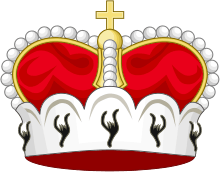Serbian nobility
Serbian nobility (Serbian: Srpsko plemstvo/Српско племство) refers to the historical privileged order or class (aristocracy) of Serbia, that is, the medieval Serbian states, and after the Ottoman conquests of Serbian lands in the 15th and 16th centuries, Serbian noble families of the Kingdom of Hungary, Republic of Venice, and the Habsburg Monarchy. Notable are also Serbian families that gained nobility in Russian Empire. With the independence of Serbia in the 19th century, a new aristocracy arose.
Middle Ages
In the medieval Serbian states, the privileged class consisted of nobility and clergy, distinguished from commoners, part of the feudal society. The nobility (vlastela) were roughly grouped into "magnates" (velikaši) and the lesser nobility (vlasteličići). Serbia followed the Byzantine model.
Early Modern period
After the Ottoman conquest in the 15th and 16th centuries, large migrations of Serbs followed into the Pannonian Plain. The community in the Kingdom of Hungary, and subsequently Habsburg Monarchy, were known as "Rascians". Serbs distinguished themselves as warriors and diplomats, and enrolled in Austrian, Transylvanian or Wallachian services.[1] After the fall of Vienna in 1683, Serbian warriors left for Austria and Russia where they obtained high ranks and honors in the armies, and once again a new level of nobility emerged.[1] Similarly, towards the Adriatic, the Frontier Serbs, outlaw hajduks and Uskoks waged war against the Ottomans, and were bestowed noble titles by the Republic of Venice.[1]
Serbian Revolution
See also
References
- 1 2 3 Dimitrije Djordjević; Richard B. Spence (1992). Scholar, patriot, mentor: historical essays in honor of Dimitrije Djordjević. East European Monographs. p. 148. ISBN 978-0-88033-217-0.

